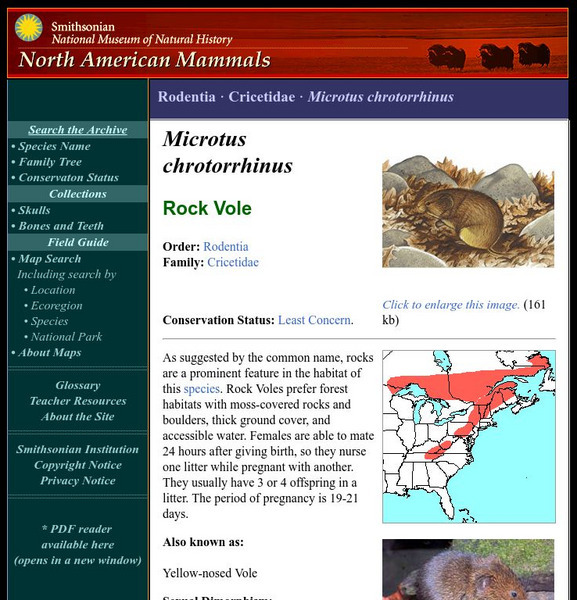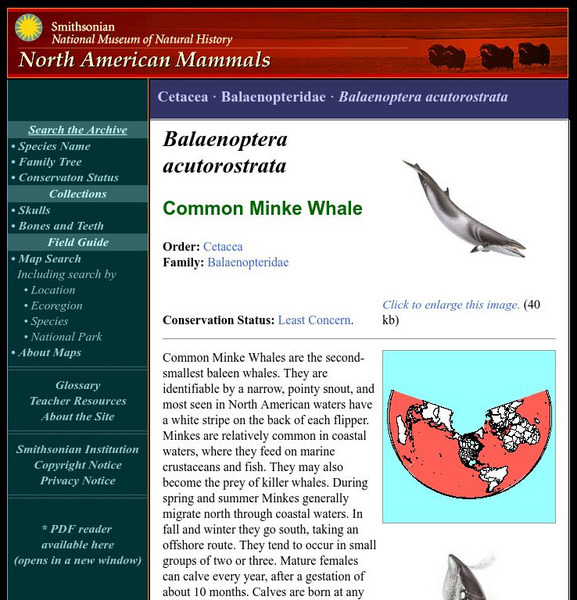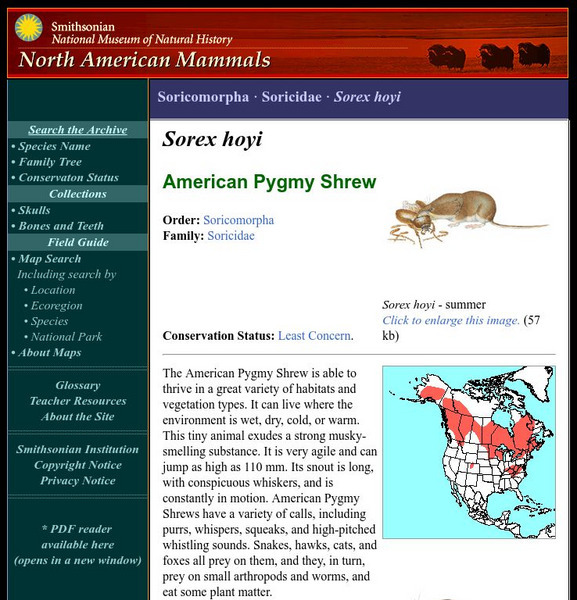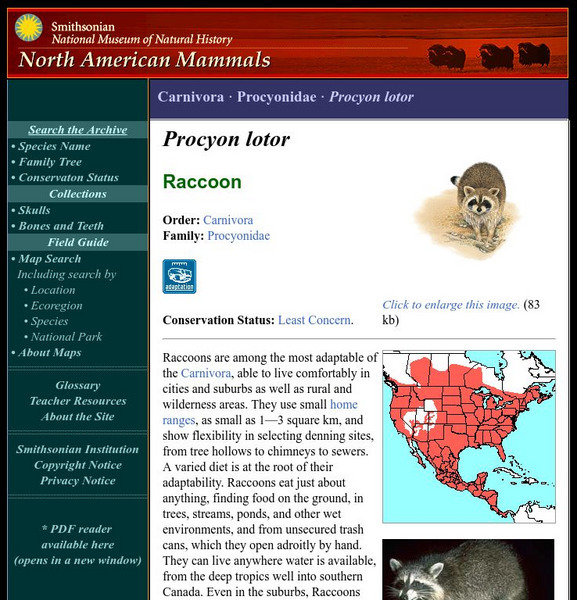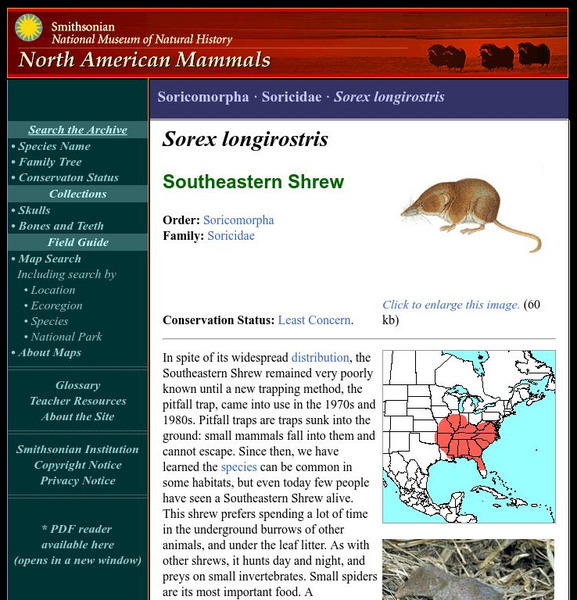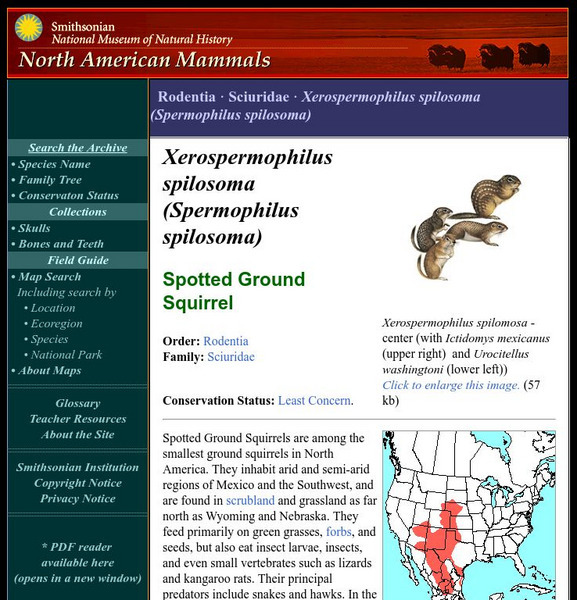Smithsonian Institution
National Museum of Natural History: American Mammals: Singing Vole
Singing Voles are known for two remarkable behaviors. One is the construction of hay piles to provide food during the long northern winters. Learn more about the Microtus miurus, more commonly known as a Singing Vole, in this...
Smithsonian Institution
National Museum of Natural History: American Mammals: Rock Vole
As suggested by the common name, rocks are a prominent feature in the habitat of this species. Rock Voles prefer forest habitats with moss-covered rocks and boulders, thick ground cover, and accessible water. Learn more about the...
Smithsonian Institution
National Museum of Natural History: American Mammals: Common Minke Whale
Common Minke Whales are the second-smallest baleen whales. They are identifiable by a narrow, pointy snout, and most seen in North American waters have a white stripe on the back of each flipper. Learn more about the Balaenoptera...
Smithsonian Institution
National Museum of Natural History: American Mammals: Mule Deer
Mule Deer live in a broad range of habitats - forests, deserts, and brushlands. Mountain populations migrate to higher elevation in warmer months, looking for nutrient-rich new-grown grasses, twigs, and shrubs. Learn more about the...
Smithsonian Institution
National Museum of Natural History: American Mammals: American Pygmy Shrew
The American Pygmy Shrew is able to thrive in a great variety of habitats and vegetation types. It can live where the environment is wet, dry, cold, or warm. Learn more about the Sorex hoyi, more commonly known as a Pygmy Shrew, in this...
Smithsonian Institution
National Museum of Natural History: American Mammals: Southeastern Myotis
The southeastern myotis occurs as far west as northeastern Texas and southwestern Oklahoma. Its preferred daytime roosts are caves with pools of water. Learn more about the Myotis austroriparius, more commonly known as a Southeastern...
Smithsonian Institution
National Museum of Natural History: American Mammals: White Nosed Coati
White-nosed Coatis are the most diurnal members of the family Procyonidae. They often sleep curled up in trees, and come down at dawn to forage, rooting with their long, mobile snouts and digging with long, curved claws for insects,...
Smithsonian Institution
National Museum of Natural History: American Mammals: Ringed Seal
Ringed Seals have dark gray or blackish coats with white or pale gray rings splotched across the back and sides. They are the smallest and most common earless seals of the icy northern seas. Learn more about the Phoca hispida, more...
Smithsonian Institution
National Museum of Natural History: American Mammals: Western Pipistrelle
Western pipistrelles sometimes leave their roosts before sundown and can be mistaken for late-flying butterflies, because they are so tiny and fly slowly and erratically, with much fluttering of their wings. Most common at low elevations...
Smithsonian Institution
National Museum of Natural History: American Mammals: Northern Raccoon
Raccoons are among the most adaptable of the Carnivora, able to live comfortably in cities and suburbs as well as rural and wilderness areas. They use small home ranges, as small as 1x3 square km, and show flexibility in selecting...
Smithsonian Institution
National Museum of Natural History: American Mammals: Southeastern Shrew
In spite of its widespread distribution, the Southeastern Shrew remained very poorly known until a new trapping method, the pitfall trap, came into use in the 1970s and 1980s. Pitfall traps are traps sunk into the ground: small mammals...
Smithsonian Institution
National Museum of Natural History: American Mammals: Pacific Shrew
An inhabitant of Oregon's moist streamsides, thickets, and woods, the Pacific Shrew does best in areas with brushy vegetation and fallen decaying logs. There it finds centipedes, slugs, and snails, insect larvae, amphibians, fungi, and...
Smithsonian Institution
National Museum of Natural History: American Mammals: Ornate Shrew
Since the Ornate Shrew is grayish-brown, with paler grayish underparts, and is small and inconspicuous overall, one may wonder about the inspiration for its name. Did it remind the biologist who named it, in 1895, of a well-dressed but...
Smithsonian Institution
National Museum of Natural History: American Mammals: Mt. Lyell Shrew
The Mt. Lyell Shrew occurs only in the central Sierra Nevada Mountains of California and is found only at elevations above 2,000 m. Learn more about the Sorex lyelli, more commonly known as a Mt. Lyell Shrew, in this easy-to-read species...
Smithsonian Institution
National Museum of Natural History: American Mammals: Vagrant Shrew
Vagrant Shrews live in moist habitats throughout their range. They are common in lakeside or streamside communities of sedges, grasses, and willows, and in coastal salt marshes. Learn more about the Sorex vagrans, more commonly known as...
Smithsonian Institution
National Museum of Natural History: American Mammals: Tundra Shrew
Many shrews have such uniformly grayish coats that separate species cannot easily be distinguished, but both the summer and winter coats of the Tundra Shrew are highly distinctive. Its summer pelage is tricolored, dark brown on the back,...
Smithsonian Institution
National Museum of Natural History: American Mammals: Spotted Ground Squirrel
Spotted Ground Squirrels are among the smallest ground squirrels in North America. They inhabit arid and semi-arid regions of Mexico and the Southwest and are found in scrubland and grassland as far north as Wyoming and Nebraska. Learn...
Smithsonian Institution
National Museum of Natural History: American Mammals: Wyoming Ground Squirrel
Wyoming Ground Squirrels are found in three separate regions of the western United States at elevations above 1,500 meters. Their geographic centers are in southwestern Montana, central and southwestern Wyoming, and southwestern Idaho,...
Smithsonian Institution
National Museum of Natural History: American Mammals: Swamp Rabbit
The Swamp Rabbit is the largest North American cottontail, but has relatively short ears in proportion to its size. It forages for grasses, sedges, some tree seedlings, and other plants in marshy lowlands of the south-central United...
Smithsonian Institution
National Museum of Natural History: American Mammals: Marsh Rabbit
Marsh Rabbits live only in marshy areas, and like Swamp Rabbits, are good swimmers. They are often found in habitats with pools of brackish water and plants such as cattails, water hyacinth, rush, centella, and marsh pennywort. Learn...
Smithsonian Institution
National Museum of Natural History: American Mammals: Mountain Cottontail
At dawn and dusk in the mountainous regions of the western United States, the Mountain Cottontail forages for sagebrush, western juniper, and grasses, almost always close to cover. As befits a rabbit that lives where it gets very cold,...
Smithsonian Institution
National Museum of Natural History: American Mammals: Long Tailed Pocket Mouse
The range of the Long-tailed Pocket Mouse is mostly within the Mojave Desert, Colorado Desert, and the Great Basin. On cold nights, this animal becomes inactive and usually remains within its burrow system during winter. Learn more about...
Smithsonian Institution
National Museum of Natural History: American Mammals: Siskiyou Chipmunk
Siskiyou chipmunks have their own, distinct vocalization: a long, intense, one-syllable call that starts low, rises, and then falls again. It starts at a frequency of about 300 kHz, rises to more than 1,600 kHz, then falls to about 400...
Smithsonian Institution
National Museum of Natural History: American Mammals: Swift Fox
Swift foxes are primarily nocturnal, but can sometimes be seen sunning themselves near the entrance to a den. They live on prairie grasslands just east of the Rocky Mountains. Learn more about the Vulpes velox, more commonly known as a...

